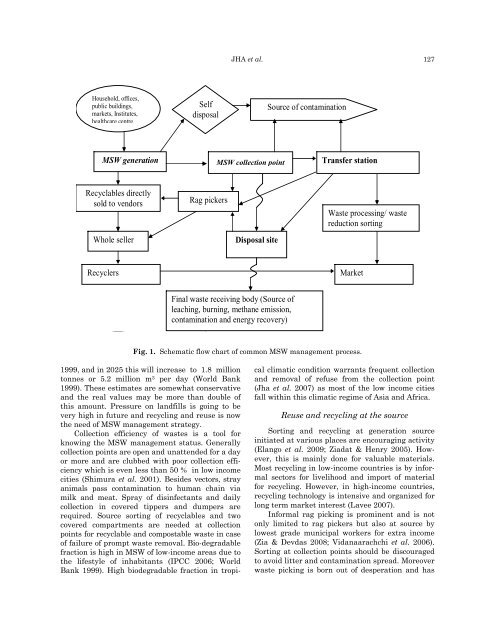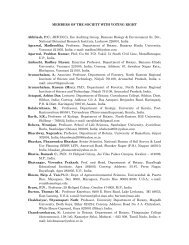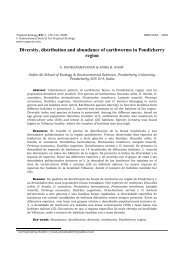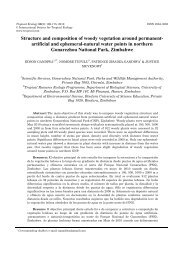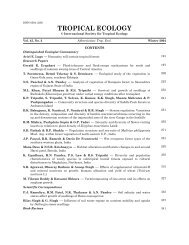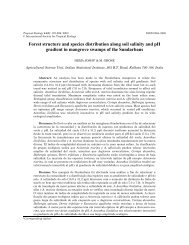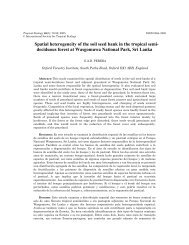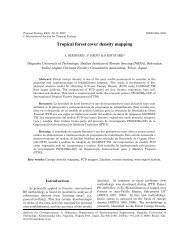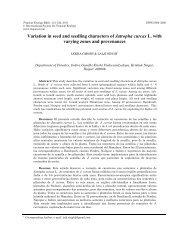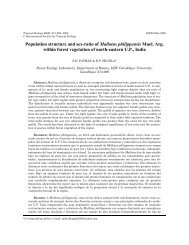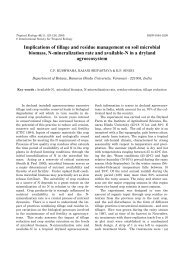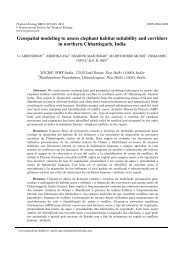Sustainable municipal solid waste management in ... - ResearchGate
Sustainable municipal solid waste management in ... - ResearchGate
Sustainable municipal solid waste management in ... - ResearchGate
Create successful ePaper yourself
Turn your PDF publications into a flip-book with our unique Google optimized e-Paper software.
JHA et al. 127<br />
Household, offices,<br />
public build<strong>in</strong>gs,<br />
markets, Institutes,<br />
healthcare centre<br />
Self<br />
disposal<br />
Source of contam<strong>in</strong>ation<br />
MSW generation<br />
MSWCollection collection po<strong>in</strong>t<br />
Transfer station<br />
Recyclables directly<br />
sold to vendors<br />
Whole seller<br />
Rag pickers<br />
Disposal site<br />
Waste process<strong>in</strong>g/ <strong>waste</strong><br />
reduction sort<strong>in</strong>g<br />
Recyclers<br />
Market<br />
F<strong>in</strong>al <strong>waste</strong> receiv<strong>in</strong>g body (Source of<br />
leach<strong>in</strong>g, burn<strong>in</strong>g, methane emission,<br />
contam<strong>in</strong>ation and energy recovery)<br />
Fig. 1. Schematic flow chart of common MSW <strong>management</strong> process.<br />
1999, and <strong>in</strong> 2025 this will <strong>in</strong>crease to 1.8 million<br />
tonnes or 5.2 million m 3 per day (World Bank<br />
1999). These estimates are somewhat conservative<br />
and the real values may be more than double of<br />
this amount. Pressure on landfills is go<strong>in</strong>g to be<br />
very high <strong>in</strong> future and recycl<strong>in</strong>g and reuse is now<br />
the need of MSW <strong>management</strong> strategy.<br />
Collection efficiency of <strong>waste</strong>s is a tool for<br />
know<strong>in</strong>g the MSW <strong>management</strong> status. Generally<br />
collection po<strong>in</strong>ts are open and unattended for a day<br />
or more and are clubbed with poor collection efficiency<br />
which is even less than 50 % <strong>in</strong> low <strong>in</strong>come<br />
cities (Shimura et al. 2001). Besides vectors, stray<br />
animals pass contam<strong>in</strong>ation to human cha<strong>in</strong> via<br />
milk and meat. Spray of dis<strong>in</strong>fectants and daily<br />
collection <strong>in</strong> covered tippers and dumpers are<br />
required. Source sort<strong>in</strong>g of recyclables and two<br />
covered compartments are needed at collection<br />
po<strong>in</strong>ts for recyclable and compostable <strong>waste</strong> <strong>in</strong> case<br />
of failure of prompt <strong>waste</strong> removal. Bio-degradable<br />
fraction is high <strong>in</strong> MSW of low-<strong>in</strong>come areas due to<br />
the lifestyle of <strong>in</strong>habitants (IPCC 2006; World<br />
Bank 1999). High biodegradable fraction <strong>in</strong> tropical<br />
climatic condition warrants frequent collection<br />
and removal of refuse from the collection po<strong>in</strong>t<br />
(Jha et al. 2007) as most of the low <strong>in</strong>come cities<br />
fall with<strong>in</strong> this climatic regime of Asia and Africa.<br />
Reuse and recycl<strong>in</strong>g at the source<br />
Sort<strong>in</strong>g and recycl<strong>in</strong>g at generation source<br />
<strong>in</strong>itiated at various places are encourag<strong>in</strong>g activity<br />
(Elango et al. 2009; Ziadat & Henry 2005). However,<br />
this is ma<strong>in</strong>ly done for valuable materials.<br />
Most recycl<strong>in</strong>g <strong>in</strong> low-<strong>in</strong>come countries is by <strong>in</strong>formal<br />
sectors for livelihood and import of material<br />
for recycl<strong>in</strong>g. However, <strong>in</strong> high-<strong>in</strong>come countries,<br />
recycl<strong>in</strong>g technology is <strong>in</strong>tensive and organized for<br />
long term market <strong>in</strong>terest (Lavee 2007).<br />
Informal rag pick<strong>in</strong>g is prom<strong>in</strong>ent and is not<br />
only limited to rag pickers but also at source by<br />
lowest grade <strong>municipal</strong> workers for extra <strong>in</strong>come<br />
(Zia & Devdas 2008; Vidanaarachchi et al. 2006).<br />
Sort<strong>in</strong>g at collection po<strong>in</strong>ts should be discouraged<br />
to avoid litter and contam<strong>in</strong>ation spread. Moreover<br />
<strong>waste</strong> pick<strong>in</strong>g is born out of desperation and has


